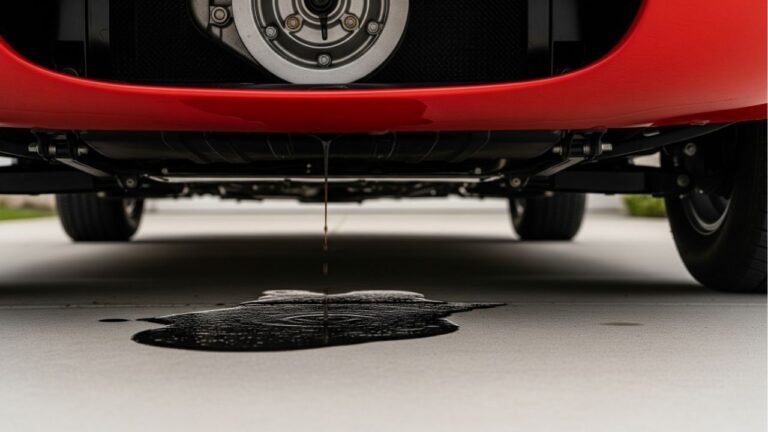Why Am I Losing Oil in My Car? — A Friendly Guide

Have you ever popped the hood, pulled out the dipstick, and felt your heart drop when you saw the oil level was low again—even though you just topped it up a week ago?
Yeah, I’ve been there too.
It can be frustrating, confusing, and sometimes downright scary. Cars are supposed to burn gas, not lose oil, right? So when your car starts behaving like it’s sipping oil like morning tea, it’s only natural to wonder, “Why am I losing oil in my car?”
This guide is here to walk you through every possible reason behind it—step by step. We’ll talk leaks, burns, engine quirks, and even a few sneaky culprits you probably wouldn’t expect. I’ll explain everything in simple language, just like a friend giving you a hand in the garage. So, grab a cup of coffee and let’s dive in!
The Two Faces of Oil Loss: Burn or Leak?

-
Leaking oil onto the ground or engine
-
Burning oil inside the engine
Sometimes, it might be doing both.
Understanding which type of loss you’re dealing with is the first step. Here’s a quick table to help you figure it out:
| Symptom | Likely Cause | What It Means |
|---|---|---|
| Oil stains under the car | External leak | Oil is dripping out |
| Blue smoke from the exhaust | Internal burning | Oil is being burned with fuel |
| No visible signs but low oil | Hidden leak or burn | Oil is escaping or burning silently |
| Smell of burning oil | Leak onto engine | Oil is touching hot components |
So before you go digging into the engine, take a moment to observe. Smell the air. Look under the car. Peek at the exhaust. These clues are your car’s way of talking to you.
1. External Oil Leaks: The Obvious Culprit
Let’s start with the most common and visible cause—external oil leaks.
If you’re spotting little oil puddles on your driveway or garage floor, your car is trying to tell you something. Think of it as your car crying for help, one drop at a time.
Common sources of external oil leaks:
-
Oil pan gasket
-
Valve cover gasket
-
Rear main seal
-
Oil filter or drain plug
-
Timing cover seal
Each of these seals and gaskets is like the lid of a container—if it’s cracked or worn out, oil slips out.
A Quick Story:
Last winter, I noticed small brown stains under my Civic. At first, I ignored them. Then the dipstick started reading low every week. It turned out to be a torn valve cover gasket—an easy fix but a costly delay. If I’d acted sooner, I could’ve saved money (and stress).
Why it matters:
Oil isn’t just lubricant. It’s your engine’s life force. Without it, metal grinds on metal, heat rises, and things go bad—fast.
2. Burning Oil Internally: When It Vanishes Into Thin Air
Now, this one’s sneakier. You may not see any leaks, but your oil level keeps dropping.
What gives?
Your car might be burning oil inside the engine, which means oil is sneaking into the combustion chamber and getting fried along with fuel. You’ll usually see blue or bluish-gray smoke from the exhaust if this is happening.
Common reasons for internal oil burning:
-
Worn piston rings
-
Bad valve seals
-
Old cylinder walls
-
PCV (Positive Crankcase Ventilation) valve malfunction
When any of these parts wear down, they let oil slip past and burn up during combustion. The result? Disappearing oil and smoky surprises.
A Metaphor to Understand It:
Think of your engine as a pressure cooker. If the seals inside aren’t tight, some of the oil leaks into places it shouldn’t be—like steam escaping from the lid.
How to tell:
-
Check for blue exhaust smoke
-
Watch for engine misfires
-
Monitor oil levels over time
-
Look for carbon deposits on spark plugs
3. A Faulty PCV System: The Silent Oil Thief
Let’s zoom in on the PCV valve, one of the most overlooked parts when people ask, “Why am I losing oil in my car?”
This valve controls pressure inside your engine and reroutes gases back into the intake. But when it fails, oil mist can get sucked into the engine and burned away—without leaving a trace.
Why This Matters:
A faulty PCV valve won’t always throw a check engine light. It just causes small, consistent oil loss over time. And because it’s not technically a “leak,” many people overlook it entirely.
Signs of a bad PCV valve:
-
Poor fuel economy
-
Engine hesitation or rough idle
-
Oil in the air filter
-
Blue smoke during acceleration
Luckily, replacing a PCV valve is cheap and easy. It’s like changing a lightbulb in your engine.
4. Oil Filter and Drain Plug Problems
You may have just changed your oil—fresh oil, new filter, smooth ride. But a week later, the oil light flickers on. What gives?
Chances are, something went wrong during the oil change.
Common oil change issues:
-
Loose or double-gasketed oil filter
-
Improperly torqued drain plug
-
Cracked oil filter housing
-
Forgotten crush washer on plug
One of my friends once forgot to remove the old oil filter gasket before screwing on the new one. The result? Oil spewed all over the driveway within minutes. Always double-check the seal and tightness!
Pro Tip: After every oil change, check under your car for signs of drips or weeps. It takes 30 seconds and could save your engine.
5. Overfilled or Wrong Oil Type
Believe it or not, using the wrong oil can cause oil to disappear mysteriously too.
If you overfill your engine, pressure builds and forces oil past seals. If you use oil that’s too thin (say, 0W-20 instead of 5W-30), it can slip into combustion chambers or leak out easier.
Symptoms of wrong oil:
-
Frothy oil on dipstick
-
Engine knock or rattle
-
Oil warning lights
-
Poor gas mileage
Check your owner’s manual and stick to the recommended viscosity. Don’t guess—this is your engine’s diet. Would you feed spicy food to a baby? Same idea.
6. Old Age and High Mileage Woes
If your car is pushing 100,000 miles or more, oil loss may be part of life now.
With age, seals harden, parts wear down, and tolerances widen. Even if everything’s working “fine,” your car could still be sipping oil between meals.
This doesn’t mean your car is broken—it just needs more love. Think of it like your grandpa needing a walking cane. It’s normal, but still needs attention.
Tips for high-mileage engines:
-
Use high-mileage oil formulas
-
Monitor oil every 500-1000 miles
-
Fix minor leaks quickly
-
Avoid hard acceleration
7. Turbocharged Engines and Oil Loss
Do you drive a turbocharged vehicle? If so, your engine naturally runs hotter and under more pressure, which makes oil loss more common.
Turbo engines spin incredibly fast, and that heat and speed can break down oil faster. Also, turbo seals can fail and allow oil to seep into the intake or exhaust.
Clues it’s turbo-related:
-
Blue smoke under boost
-
Turbo whine or lag
-
Oily residue in intercooler pipes
Preventive steps:
-
Stick to synthetic oil
-
Don’t skip oil changes
-
Let the engine cool after hard driving
8. How to Diagnose Oil Loss at Home (Without Being a Mechanic)
You don’t need to be a certified mechanic to figure out why you’re losing oil in your car. With a few tools, a little patience, and some basic know-how, you can narrow it down yourself.
Here’s how to do it step by step:
Step 1: Check for Leaks
-
Park the car on a flat surface overnight
-
In the morning, look for dark, wet stains under the car
-
Use a UV dye kit (available at auto stores) if leaks are hard to see
Step 2: Monitor Oil Level Consistently
-
Check your oil level every 500 km or once a week
-
Use the dipstick and make note of how much it drops
-
Keep a log—pattern tracking helps identify trends
Step 3: Watch the Exhaust
-
Ask a friend to rev the engine while you stand behind the car
-
Look for blue or gray smoke
-
Take note of when the smoke appears (cold start, acceleration, idle?)
Step 4: Listen and Smell
-
A burning oil smell under the hood usually points to leaking oil hitting hot surfaces
-
If the engine is ticking or knocking, oil pressure may be low
Step 5: Check Spark Plugs
-
Remove a spark plug or two—oily tips may indicate burning oil
If you’re not comfortable doing these steps, that’s totally okay. But even knowing what signs to look for helps you speak clearly with a mechanic. And trust me, they will appreciate that.
9. What to Tell Your Mechanic (To Save Time and Money)
Mechanics love detail. The more info you can give, the less they have to guess—and the less they’ll charge you just to “figure it out.”
Here’s what to mention:
-
How quickly you’re losing oil
-
Any visible leaks
-
If you see smoke or smell burning oil
-
Whether oil loss happens more during city driving or highway driving
-
If the car is running differently (noises, stalling, reduced power)
Take a photo or video of the leak, dipstick, or smoke if you can. Think of it like showing a doctor a picture of a rash—it’s just easier than explaining.
10. Is Oil Loss Dangerous? (Spoiler: Yes, It Can Be)
Now let’s get serious for a moment.
Losing oil in your car is not just an inconvenience—it’s a threat to your engine’s life.
Here’s why:
-
Oil lubricates moving parts
-
It keeps your engine cool
-
It prevents metal-on-metal wear
-
It traps dirt and debris
Without enough oil, your engine will overheat, parts will seize, and in the worst-case scenario, you’ll need a full engine replacement.
That’s not cheap.
So even if your car seems to be running fine, if oil is disappearing, take action. Fast.
11. What’s the Cost of Fixing Oil Loss?
This depends entirely on the cause. Here’s a breakdown:
| Cause | Repair Needed | Estimated Cost (USD) |
|---|---|---|
| Valve Cover Gasket Leak | Replace gasket | $100 – $300 |
| Oil Pan Gasket | Remove and reseal | $200 – $500 |
| Rear Main Seal | Transmission removal required | $700 – $1,500 |
| Bad PCV Valve | Replace valve | $50 – $150 |
| Worn Piston Rings | Engine rebuild | $1,000 – $4,000+ |
| Turbo Seal Failure | Turbo replacement | $800 – $2,500 |
If you’re losing oil slowly and repairs are expensive, consider adding oil regularly as a temporary solution. Just don’t ignore it completely.
12. Preventing Oil Loss in the Future
Let’s be proactive now. Preventing oil loss is easier and cheaper than fixing it.
Here’s what you can do:
-
Change your oil on time: Don’t stretch it out
-
Use the right oil: Follow your car’s recommended viscosity
-
Check oil monthly: It takes 2 minutes and can save your engine
-
Watch for leaks: Catch drips early
-
Warm up the car gently: Especially in cold weather
-
Fix small issues quickly: A $20 gasket today saves $200 tomorrow
Cars are like relationships—they need attention, regular care, and occasional tune-ups. Ignore small problems, and they grow.
13. Emotional Side of Car Troubles: You’re Not Alone
Let’s be honest—car trouble can be really stressful.
You might feel frustrated, anxious about repair costs, or even a little embarrassed for not noticing the signs sooner. That’s totally normal.
I’ve personally driven a car that needed a quart of oil every other week. I carried bottles in the trunk like they were bottled water. And yes, I even once fried an engine by ignoring the low oil light.
The key is not to blame yourself—it’s to learn and adapt. Car ownership is a journey, and oil loss is just one of the lessons.
FAQs About Losing Oil in Your Car
Q1: Can I keep driving if my car is losing oil?
If it’s a minor leak or slow loss, you can drive temporarily—but check oil levels daily. If it’s leaking fast or showing the oil warning light, stop immediately.
Q2: Does synthetic oil reduce oil loss?
Yes. Synthetic oil handles heat better and resists breakdown, which can reduce leaks and burning in some engines.
Q3: What happens if I don’t fix the oil loss?
Eventually, your engine could overheat, wear down, or completely seize—leading to very costly repairs or even engine replacement.
Q4: Can an oil additive help reduce oil burning?
Some high-mileage additives can help swell gaskets and slow leaks. But they’re a short-term solution, not a fix.
Q5: How often should I check my oil if I’m losing it?
Check it every 3-5 days or every 300-500 km until the issue is fixed.
Q6: Why is there no oil leak, but the level drops?
Your engine might be burning oil internally. This is often due to worn seals or piston rings.
Q7: How long does it take to fix a common oil leak?
Simple fixes (like a valve cover gasket) take 1-2 hours. Complex repairs (like piston rings) can take several days.
Q8: Is it normal for older cars to lose oil?
Yes. Cars over 100,000 miles often lose a little oil. Regular top-offs and using high-mileage oil helps manage it.
Final Thoughts: Know Your Car, Protect Your Engine
So, the next time you ask yourself, “Why am I losing oil in my car?”, you won’t be left in the dark. You’ll know what to check, how to interpret the signs, and what steps to take.
Every drop of oil matters. It’s the lifeblood of your engine, and keeping an eye on it is one of the smartest things you can do as a car owner.
Keep your ears open, your nose ready, and your dipstick handy—and you’ll keep your car running strong for miles to come.






